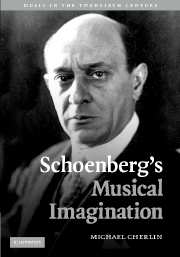Book contents
- Frontmatter
- Contents
- List of music examples and figures
- Acknowledgements
- Introduction
- 1 A passing of worlds: Gurrelieder as Schoenberg's reluctant farewell to the nineteenth century
- 2 Dialectical opposition in Schoenberg's music and thought
- 3 Dramatic conflict in Pelleas und Melisande
- 4 Motive and memory in Schoenberg's First String Quartet
- 5 Uncanny expressions of time in the music of Arnold Schoenberg
- 6 The tone row as the source of dramatic conflict in Moses und Aron
- 7 The String Trio: metaleptic Schoenberg
- Notes
- Bibliography
- General index – names and topics
- Index of Schoenberg's works and writings
6 - The tone row as the source of dramatic conflict in Moses und Aron
Published online by Cambridge University Press: 22 September 2009
- Frontmatter
- Contents
- List of music examples and figures
- Acknowledgements
- Introduction
- 1 A passing of worlds: Gurrelieder as Schoenberg's reluctant farewell to the nineteenth century
- 2 Dialectical opposition in Schoenberg's music and thought
- 3 Dramatic conflict in Pelleas und Melisande
- 4 Motive and memory in Schoenberg's First String Quartet
- 5 Uncanny expressions of time in the music of Arnold Schoenberg
- 6 The tone row as the source of dramatic conflict in Moses und Aron
- 7 The String Trio: metaleptic Schoenberg
- Notes
- Bibliography
- General index – names and topics
- Index of Schoenberg's works and writings
Summary
Unsere Gesetze sind nicht allgemein bekannt, sie sind Geheimnis der kleinen Adelsgruppe, welche uns beherrscht. [Our laws are not generally known; they are the secret of the small group of nobles who rule us.]
Franz Kafka, “Zur Frage der Gesetze”Vor dem Gesetz steht ein Türhüter. [Before the law stands a doorkeeper.]
Franze Kafka, “Vor dem Gesetz”Nah sind wir, Herr,
nahe und greifbar.
[We are near, Lord,
near and at hand.]
Paul Celan, “Tenebrae” [translated by Michael Hamburger]Introduction
Schoenberg's opera Moses und Aron constitutes one of the composer's central achievements. It is a work of great dramatic impact, rich sonic complexity, and profound spiritual and philosophical inquiry. It is also the locus for Schoenberg's most extended exploration of twelve-tone composition. After the Introduction to this chapter places the work into an historical context, our primary focus will be on the ways that conflict is built into the twelve-tone row as it induces mutually exclusive partitions of itself and then generates derived partitions that develop and interact with those primary partitions. The partitioned row forms are used to portray individuation and conflict among the opera's protagonists. They also raise questions about cognition and perception that are at the core of Schoenberg's musical expressivity. Having developed an extensive, although by no means exhaustive study of the row's properties, the penultimate section of the chapter inquires more deeply about Schoenberg's portrayal of God, Moses, and the music of the covenant within the opera's first scene.
- Type
- Chapter
- Information
- Schoenberg's Musical Imagination , pp. 230 - 298Publisher: Cambridge University PressPrint publication year: 2007



